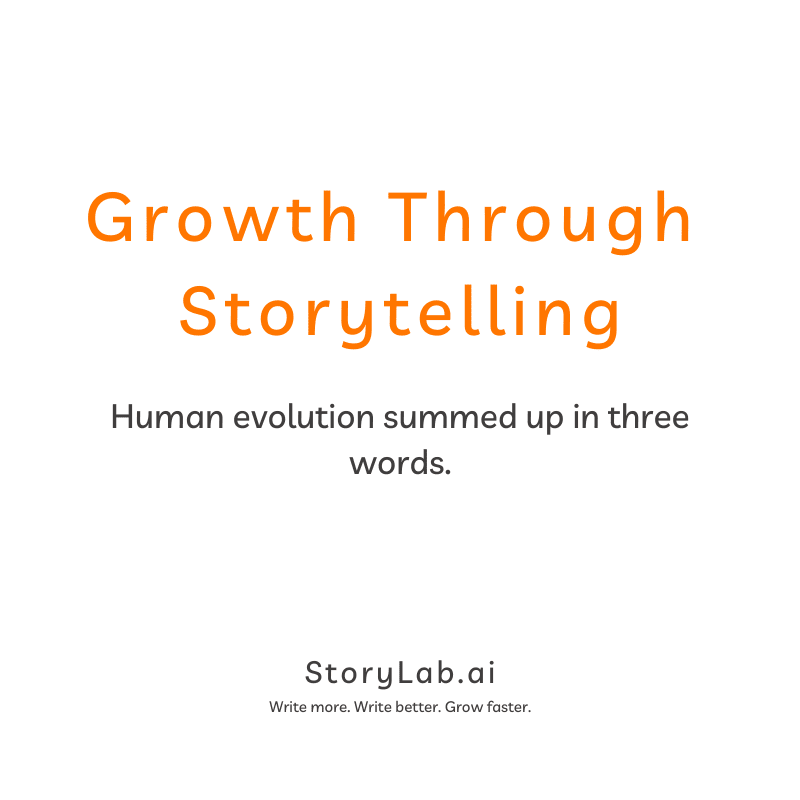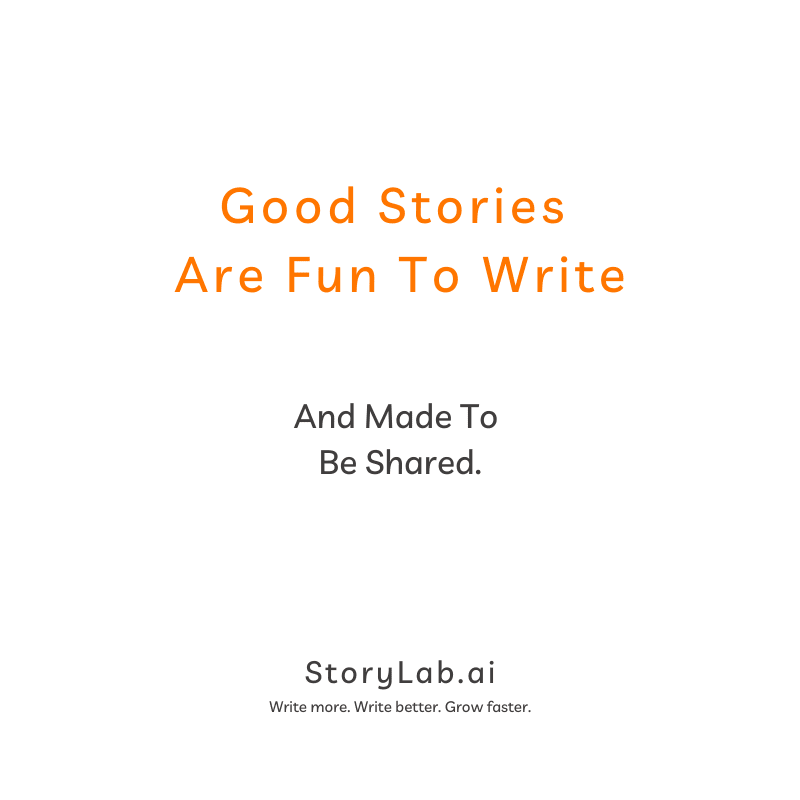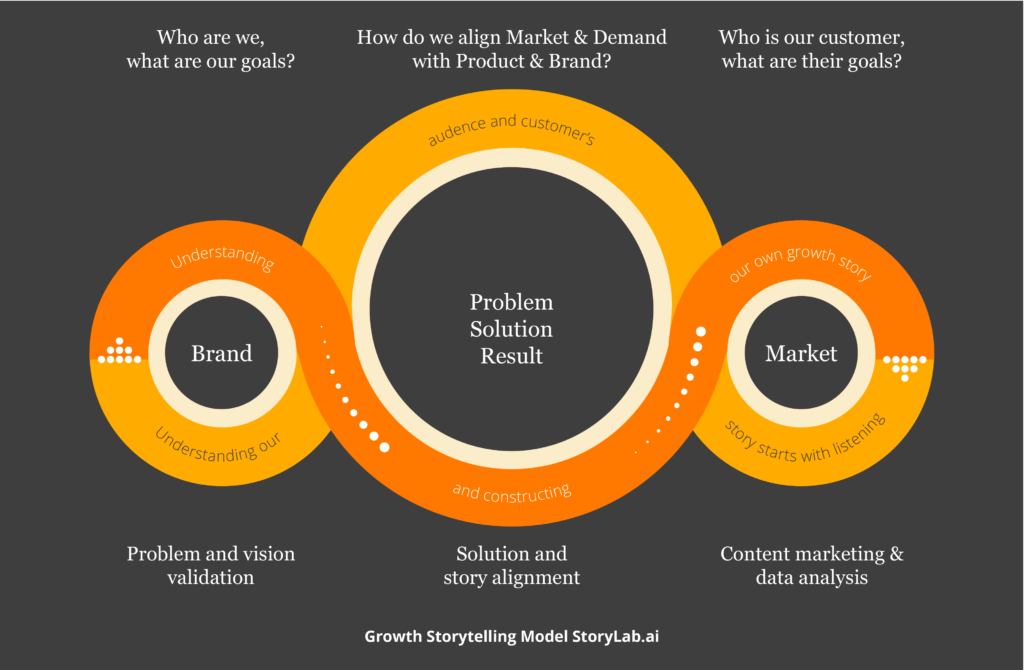Growth Storytelling
A New Vision and Approach to Content Marketing
How a focus on growth, storytelling, and human connection will change your life as a marketer
We started StoryLab.ai in august 2021, with the goal of helping you to write more, write better, and grow faster — with the help of our combined 40 years of marketing expertise and our AI copy generators.
Along the way, and about 10,000 users into our own story, we figured something out. Something that we were partially already doing, and already talking about in our strategy meetings as well as in our content.
Something that has very little to do with the ‘AI’ part of our name, and something that we believe will change the face of content marketing.
Something that we know, as soon as we own and commit to it completely, will catapult StoryLab.ai into the next phase of sustainable growth — in terms of our own growth goals as well as those of our users and our audience.
Growth Storytelling is a new approach to content marketing.
Here’s why that’s necessary.

Move over, content marketing
‘Content marketing’ as a phrase was coined in 1996, by John F. Oppedahl, at a discussion for journalists at the American Society for Newspaper Editors.
It became a phrase that has since made waves in the marketing and tech worlds to such an extent, that as much as we live in a digital age today where everything is data —
We also live in an era in which everything is content.
That brings a couple of problems along with it for human beings and for society, which merit a whole other book about digital overload, and which we won’t go into today.
But it also brings along with it some problems for marketers, which we at StoryLab.ai are hoping to solve with a new vision and a new approach.
With this story, we’re gonna explain what we mean when we say Growth Storytelling; the problems it solves, and how it works.
We’ll also be eating our own dog food and doing the thing we’re explaining while we’re explaining it. We’re very meta like that. Stay tuned.
The problem with content marketing that we’re trying to solve
The world adopted the language and practices of content marketing at about the same breakneck speed that it adopted data-driven marketing, social media, and other digital channels.
This is no coincidence; these developments necessarily go hand in hand.
The main problem that the blanket-covering of our online experience, as well as of marketing strategies and tactics with the ideas of ‘content marketing’ has brought for marketers, can be summed up as follows:
Marketers don’t know which content to focus on because they don’t know what will work; because of that they experience a need to create far more content than they have the capacity to create; the content that they end up creating doesn’t have the desired effects of;
-
Helping their audience in meeting their goals or to grow; thereby generating raving fans and a trusting, hungry audience;
-
Generating the views, engagement, clicks and conversions that support business growth goals.
The core of the problem
At the basis of the above problems, lies the following:
- We don’t focus enough on supporting the achievement of Goals and Growth for our customers; we don’t focus enough on what our customers really want and need;
- We don’t focus enough on the basis of human connection and communication which lies in Storytelling and in listening;
- As a consequence of 1 and 2, we have sluggish, frustrating and ineffective content marketing processes set up that make us make a lot of the wrong decisions for all of the wrong reasons.
Sluggish content marketing process
The content marketing processes we’re talking about — and that we’d love to hear from you if you recognize, go a little something like this:
- A CMO gets the assignment to create a (content) marketing strategy, starting with strategic business goals for the company;
- Research is conducted as to what the market, competitors and potential clients or customers are doing; what they’re looking for (SEO and other market research often in the form of static reports) and what they’re responding to (hashtags, content types, engagement);
- A theoretical customer journey is created based on the above, with — if you’re lucky — one or more customer-facing employees guesstimating what clients or potential clients might need, want, or wonder along the customer journey;
- A content creation and publication roadmap is set up;
- KPI’s are set up to measure the effectiveness of content;
- Content pieces are ideated, created, reviewed and changed — often over multiple touchpoints and often multiple cycles — without ever consulting real world data and/or actual customers;
- Content is published in the form and formats, and across the channels that the internal organization has deemed to be the most likely to be successful;
- Data is analyzed to determine which shots in the dark have actually been most successful, and the content strategy is revised.
The problem with this approach, next to it being slow, sluggish, frustrating and relatively ineffective for the most part, is:
We only think about what our customers really want and need as an afterthought and literally after the fact.
Here’s how Growth Storytelling will help us fix these problems:

What Growth Storytelling is and how it’s different
Growth Storytelling is a vision of and an approach to content marketing that focuses on Growth: more specifically, where our Growth goals as a company and the (Growth*) Goals of our audience and potential customers align.
*=”Goals” are always applicable. In B2B, “Growth goals” make sense. In B2C, not always.
What Growth Storytellers focus on
Growth Storytelling focuses on telling the stories that we know will connect with our intended audience, because we’ve done our research and — shockingly — we’ve asked them, and actually listened to them.
Growth Storytelling takes audience insights in the form of quantitive and wherever possible, qualitative data, combines them with marketing and business goals, and places that front and center in:
- How we construct and evolve our Brand Story and Brand Identity;
- How we construct and evolve our product, business strategy, and marketing goals;
- How we construct and evolve our marketing strategy and tactics;
- And how we create, review, distribute and measure our individual content pieces.
The main difference being:
- We focus on growth for our customer.
- We focus on telling stories and listening to our customer.
- We use quantitative data and qualitative insights about our audience and potential customers as a starting point, rather than as a late check box.
The Growth Storytelling Model
Here’s what that looks like in a graph:

1 — Brand Growth Story Flow: From upper left to right, you see a flow of energy moving through these three circles. This flow of information and energy is described as:
“Understanding, constructing and telling our Own Growth Story”.
2 —Customer Growth Story Flow: The Flow starting from the bottom right, is described as:
“Listening to and understanding our audience’s & customer’s story.”
These two flows move through three cycles; ‘Brand’, ‘Solution & Story’, and ‘Market’:
Brand
As you can see in the above diagram, in the Brand cycle (on the left) we focus on Brand Identity, answering the question “Who are we and what are our growth goals?” What do we stand for? What problem(s) do we focus on solving? What is our vision for the future?
Market
In the most outer right circle, the Market, we focus on figuring out who our customers or audience is, and what their Growth Goals are. What are the needs and problems that they themselves perceive to have? What are their desired outcomes?
Solution & Story
This middle circle is where it all comes together. This is where we align our own Growth Story with our audience’s Growth Story. It’s also where we make sure that our product (Solution) aptly addresses the problems that our audience and customers are facing, and that it gives them the results that they want.
Additional points to consider when Growth Storytelling
- Don’t stop providing value because you don’t see the immediate results in terms of ROI. Pick a strategy, and a direction — and stick with it for at least 6 months.
- When Growth Storytelling; don’t be afraid to give ALL of the value instead of the lazy 5 bullet point articles. Check our storytelling, marketing, AI copy generation and content creation stories, here — and tell us if we’re eating our own dog food.
- The structure outlined in the Growth Storytelling diagram above, should not be followed 100% of the time. View this as a theoretical guideline for the setup of your Storytelling process.
- Getting feedback is more important than how often or how continuously you get it. 60 or 100 customer touches are not as important as getting the customer feedback in the first place.
- Growth Storytelling is also about how you structure what you’re going to write about. It’s about building your content and your stories around the Problem, Solution, Result that it’s about. This is why the circle in the middle with “Problem, Solution, Result” in it, works in two ways: for the product itself, as well as for the structure of the stories you’re telling.
Showdown: Growth Storytelling vs. Content Marketing
As you can see at first glance already: Growth Storytelling is much more holistic than Content Marketing in its approach; what is traditionally viewed as ‘Content Marketing’ is only what we do in the Market circle.
Very rarely do we see signals from the audience inform the inherent Story of the Brand, much less its products and general evolutionary directions. This is a waste of the insights and data that (content) marketing can get us. (Note: this is traditonally the role for a ‘product marketing’ person to do).
In the Growth Storytelling approach however, the qualitative and quantitative insights we glean from analysis “out there” — and partially off of the response on digital content — get taken back “inside”, all the way to redefining ourselves as a brand or a company — and redefining our story as well as our actual product.
Why Growth Storytelling will beat Content Marketing
Now, why would the above prove to work better than the traditional approach?
Because instead of focusing on getting the most eyeballs on your content, and converting the most leads, we’ll now finally be focusing on what really matters:
How to align ourselves (or better: our Growth Story) with the Goals (or better: Growth Story) of our audience and customers.
Stories rather than Goals
Why Stories rather than Goals? Growth Storytelling means understanding a customer is not a static given or person; it’s a person who has a story, with a beginning, a middle, and an end (goal). That end Goal does not exist in a vacuum.
And it means understanding that you as a brand are also a story, with a beginning, a middle, and an end — and that both the brand and the customer hopefully have a new episode or a new season coming up after the closing titles.
Growth Storytelling is about aligning goals and story arcs of one party, with those of the other. To mutual benefit and maximum growth, for both.
And hopefully to a new season. With multiple crossovers.
Focus on views, engagement and leads; get those.
Focus on Growth for your customers and your brand — and where they converge; build and tell that story — get what you really want.
What StoryLab.ai is getting right — and what we’re not
So, how does StoryLab.ai help you as a marketer to actually tell Growth Stories, and not just ‘Market Content’?
- Well, next to our AI Marketing copy generators, from day one we’ve also offered a ton of — as far as we’re seeing in our data and hearing from readers — very useful content on how to actually tell stories and do it strategically and effectively.
- Next to that we offer an entire Growth Storytelling Framework that helps you set up your Brand Identity, Storytelling, Marketing Strategy & Distribution plan — and that helps you execute and measure the effectiveness.
- Finally, on our product roadmap are various new, exciting features which we plan to be adding over the next couple of months. And which will help you to use data & customer insights in the process of constructing and evolving your marketing strategy; in improving your team’s joint content creation process, as well as in the actual production and reviewing of your individual content pieces.
OK, and how has StoryLab.ai been doing in the Growth Storytelling vs. Content Marketing department?
OK, so here’s the good news. From the get-go, we at StoryLab.ai have been awesome at doing the Growth Hacking/Digital Marketing magic that is done in the Market circle of this model.
We’ve ideated, created, measured data and improved what content we need to be sharing to get more eyeballs on our platform and our tools and man, have we grown.
However; honestly assessing our level of ‘taking our own medicine’; what we haven’t been doing enough of, are two things:
- Gathering insights from the market (especially in the form of qualitative insights from our audience and customers) and taking that back all the way into how we construct our brand identity/brand Growth Story and how we evolve our product;
- Proactively delving into our own identity and coming up with insights and stories about ourselves as a company, as individual humans and as a brand, explaining more about our vision so as to be able to resonate with more people — and specifically, more of the right people. And to see what actually does resonate. We’re kinda checking this one off right now, aren’t we?
So, where do we go from here? Simple. You tell us.
Sharing our dogfood: thanks for reading and please help out
We were genuinely a little bit afraid of sharing this story. We believe that this kind of slight fear is a good thing. We truly feel in our heart of marketing hearts that we’re on to something.
We were also a little afraid you wouldn’t still be reading this. But look at us, we’re all still here.
This story has been a first public explanation of our vision for Growth Storytelling, which we believe will change the face of Content Marketing.
Finally, we’d like to ask you for your insights. Because we truly believe in the vision we’ve outlined above. So:
If this story has struck a chord in you in any which way, shape or form, please:
- Share this article online, and respond/comment with a snippet about your views about it, and tag us @storylab.ai, or:
- Connect with us here to set up a quick chat to tell us how you think about the problems, solutions, and the future for Content Marketing and Growth Storytelling (we can also send you our questions via e-mail if you prefer that).
- Finally, you can also join our LinkedIn Group, Growth Storytelling, here. In that community, we share helpful insights, tactics and tools for content marketing, storytelling, and writing. See you there?
We’d love to hear from you.
After reading this article, we think you’ll know exactly how much we mean it.
Be sure to also check out: Employee Advocacy 2.0: Team Growth Storytelling
Top AI Marketing Generators
Author bio:
 Erwin Lima: What inspires Erwin is helping people, teams and brands to become the best version of themselves. Guiding them with curiosity, empathy, and Growth Storytelling.
Erwin Lima: What inspires Erwin is helping people, teams and brands to become the best version of themselves. Guiding them with curiosity, empathy, and Growth Storytelling.
Over the past 10+ years as a copywriter, author, consultant, and coach, he’s helped dozens of Brands, Teams, and individual human beings to grow their sense of motivation and focus, but also their reach, engagement, and revenue— through the power of their own story. You can find Erwin on LinkedIn and on his website.
Master the Art of Video Marketing
AI-Powered Tools to Ideate, Optimize, and Amplify!
- Spark Creativity: Unleash the most effective video ideas, scripts, and engaging hooks with our AI Generators.
- Optimize Instantly: Elevate your YouTube presence by optimizing video Titles, Descriptions, and Tags in seconds.
- Amplify Your Reach: Effortlessly craft social media, email, and ad copy to maximize your video’s impact.